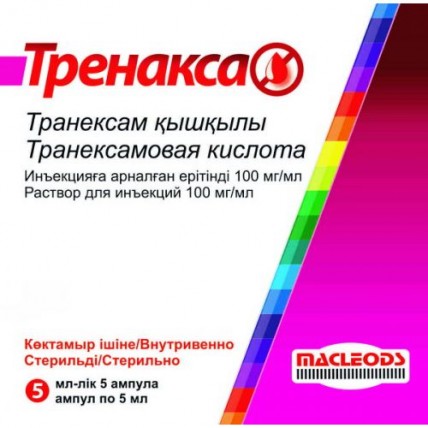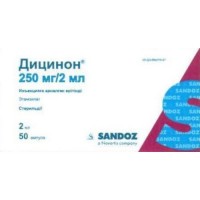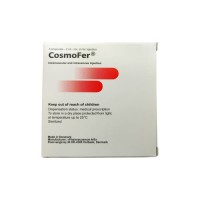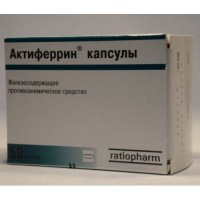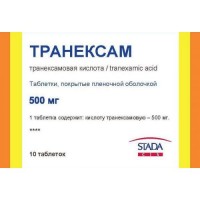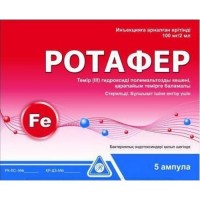Trenaxa (Tranexamic Acid) 100 mg/ml, 5 ampoules. x 5 ml
- $57.10
The instruction for medical use of TPEHAKCA medicine the Trade name of Trenaks Mezhdunarodnoye the unlicensed name Traneksamovaya acid the Dosage form Solution for intravenous administration, 500 mg / 5 ml Structure of 5 ml of solution contains active agent – traneksamovy acid of 500 mg, excipient: water for injections the Description Transparent colourless or slightly yellowish solution the Pharmacotherapeutic Blood group and bodies of a hemopoiesis. Antihemorrhagic drugs. Antifibrinolitiki. Amino acids. Traneksamovy acid. The ATX B 02AA02 code the Pharmacological Pharmacokinetics Later properties of introduction is metabolized an insignificant part of drug. Curve concentration time has the three-phase form with elimination half-life (T1/2) in a terminal phase - 2 h. In blood about 3% are connected with protein (plasminogen). The initial volume of distribution is about 9 - 12 liters. Drug, is generally removed with urine by means of glomerular filtration. The general renal clearance is equal to the general clearance from plasma (110-116 ml/min.), more than 95% of a dose are allocated with urine in not changed form. Removal of traneksamovy acid makes about 90% in 24 hours after intravenous administration in a dose of 10 mg/kg. Trenaks's pharmacodynamics - anti-fibrinolytic means. Traneksamovy acid specifically inhibits operation of the activator of plasmin and plasminogen, possesses haemo static action in the bleedings connected with increase in a fibrinolysis. Trenaksa absorbs binding sites of a lysine plasminogen of the person, moving plasminogen from the surface of fibrin that leads to fibrinolysis inhibition. Trenaksa does not influence coagulability parameters. Indications - bleedings during operation and in the postoperative period (heart surgeries, prostatectomy, orthopedic operations, tonsilectomy, adenoidectomy) - recuring epistaxis - injuries of eyes, spontaneous or postoperative hypostasis of a cornea - primary menorrhagia, menorrhagias caused by use of intrauterine contraceptives - the bleedings connected with presentation and a rupture of a placenta at pregnancy - the bleedings caused by conization of a neck of the uterus - acute gastrointestinal bleeding - bleeding after extraction of tooth at patients with hemophilia Routes of administration and doses At heart surgeries the initial dose of 10 mg/kg is entered in 20 – 30 min. before operation with the subsequent infusion of 1 mg/kg/h. Acute gastrointestinal bleedings: 4.5 - 6 g/day entered into 3-6 receptions within 5-7 days. After neck of the uterus surgery appoint 4.5 g/day entered into 3 receptions within 12–14 days. In nasal bleeding solution to injections is applied locally by burying or plugging of the nasal courses the gauze moistened with solution. Tonsilectomy: 10 mg/kg intravenously for an hour and a half before operation. Orthopedic operations: 10-15 mg/kg in the form of intravenous infusion before removal of a turnstile with the subsequent 1-2 doses with a 3-hour interval, if necessary. Adenomectomy: 10-15 mg/kg of body weight intravenously, 2-3 times a day, right after operation. Just before odontectomy at patients with hemophilia 10 mg/kg of body weight along with use of replacement therapy are entered intravenously. After odontectomy, intravenous injections in a dose of 10 mg/kg of body weight 3-4 times a day within 2-8 days are recommended. Patients with reduced renal function are recommended to lower a dose of this drug. In case of disturbance of secretory function of kidneys the correction of the mode of dosing is necessary: at concentration of creatinine in blood of 135-280 µmol/l appoint intravenously — 10 mg/kg 2 times a day, at concentration of creatinine of 280-570 µmol/l appoint intravenously in the same single dose at frequency rate of 1 times a day. In a liver failure of dose adjustment it is not required. DetiU of children since 1 for the approved indications, the dose makes 20 mg/kg/day. However data on efficiency, dosages and safety for these indications are limited.Elderly people At patients of advanced age it is necessary to approach with care the choice of a dose and to begin, as a rule, with the lower dose levels, in view of the increased frequency of cases of an abnormal liver function, kidneys or hearts and also associated diseases. Introduction method: Introduction is strict slowly intravenously. For intravenous administration drug can be mixed with the majority of solutions for infusions. To use the prepared solution right after preparation. Trenaksa can be applied with heparin. Side effects Often (≥ 1/100 to & lt, 1/10) - sensation of discomfort in a stomach and intestines, nausea, vomiting, heartburn, diarrhea Seldom (≥ 1/1000 to & lt, 1/100) - allergic reactions (rash, an itching, urticaria) Frequency is unknown - reactions of hypersensitivity, including an acute anaphylaxis - spasms, dizziness, drowsiness, weakness - arterial hypotension, tachycardia, thorax pain (especially after fast intravenous administration), orthostatic hypotension - a thrombembolia, a deep vein thrombosis, an embolism of lungs, fibrinferments of vessels of a brain - acute necrosis of a bast layer of kidneys - a disorder of vision, the Contraindication chromatopsia - hypersensitivity to drug components - patients with subarachnoidal hemorrhage (can cause hypostasis and a heart attack of a brain) - a heavy renal failure - a deep vein thrombosis, a thromboembolic syndrome in the anamnesis - a myocardial infarction - patients with the acquired anomaly of color sight - tachycardia, arterial hypotension - patients with active intravascular fibrillation - pregnancy and the period of a lactation - children's age till 1 year Medicinal interactions the Drugs considerably activating a prothrombin complex and anti-fibrinolytic drugs, estrogen should not be accepted along with traneksamovy acid as it increases risk of thrombosis. Trenaksa is incompatible with an urokinase, noradrenaline a bitartrate, a dezoksiepinefrina a hydrochloride, a metarmina a bitartrate, Dipiridamolum, diazepam. It was reported about cases of spasms of brain vessels, cerebral ischemia and decrease in a blood-groove at simultaneous use of traneksamovy acid with Chlorpromazinum. Drug should not mix up with the transfusion blood or infusions containing penicillin and tetracyclines. Special instructions Intravenous injections of traneksamovy acid need to be done very slowly. Intramuscular introduction is not allowed. Lysis of the existing extravascular blood clot can be inhibited at the patients receiving traneksamovy acid. To the patients who are on anti-fibrinolytic therapy medicines with haemo static action have to be appointed with care. In case of a renal failure consider clearance of creatinine and reduce a dose. At a renal hamaturia there is a risk of a mechanical anury as a result of formation of a clot in an urethra. Before the beginning and in the course of treatment carrying out survey of the oculist (visual acuity, color sight, an eyeground) is necessary. Retinal vascular changes at the patients receiving traneksamovy acid on an extent from several weeks to several months were not noted. Use in pediatrics Is applied in pediatric practice. Pregnancy Researches of safety of drug at pregnancy were not conducted. However, traneksamovy acid gets through a placenta and is in umbilical blood approximately in the same concentration, as in maternal blood. Therefore drug should be used only in case of emergency. The lactation period Due to the penetration of traneksamovy acid into breast milk, use of drug during feeding by a breast it is necessary to avoid. The feature of influence of medicine on ability to run motor transport and potentially dangerous mechanisms Due to the possible manifestation of side effects at administration of drug should refrain from control of motor transport and potentially dangerous mechanisms. Overdose Symptoms: nausea, vomiting, orthostatic hypotension. Treatment: symptomatic. Forms of release and packing On 5 ml of drug place in an ampoule from colourless transparent glass with the line for a break. On an ampoule paste the label. On 5 ampoules place in blister strip packaging. On 1 blister strip packaging together with the instruction for medical use in the state and Russian languages place in a pack from cardboard. To Store storage conditions at a temperature not above 25 °C. Not to freeze. To store out of children's reach! A period of storage 2 years not to apply after an expiration date Prescription status According to the prescription Immacule Lifesciences Private Limited Producer, India of Vill. Thanthewal, Ropar Road, Nalagarh, Distt. Solan the Holder of the registration certificate of Macleods Pharmaceuticals Limited, India 304, Atlanta Arcade, Marol Church Road, Andheri (East), Mumbai – 400,059 Name, the address and a contact information (phone, the fax, e-mail) of the organization in the territory of the Republic of Kazakhstan, the accepting claim (offer) on quality of medicines from consumers and responsible for post-registration observation of safety of medicine: Branch KOO Macleods Pharmaceuticals Limited in RK, Republic of Kazakhstan, Almaty, Tulebayev St. 38/61, 5 the floor, the Ph./fax. +7 727 2734593, 8 7012420565 e-mail: regulatorykazakh@macleodspharma.com.
To develop
To develop
